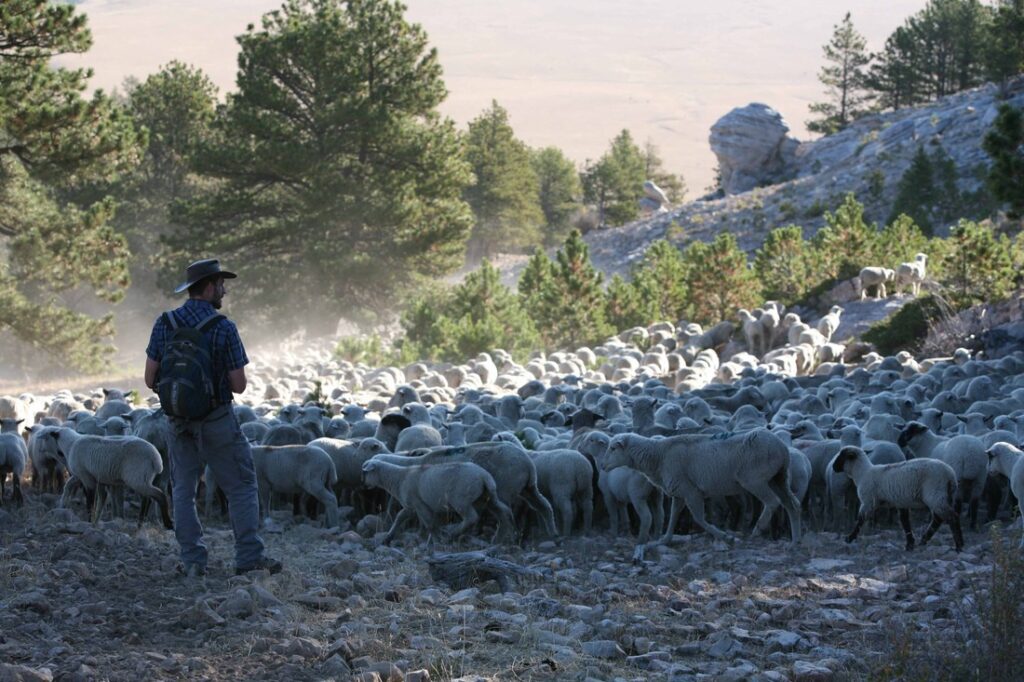Karen Hostetler didn’t grow up on a farm, but an obsession with wool fiber prompted her to spin a new business idea into motion.
“I didn’t grow up raising sheep. I did love wool and fiber. And I took a spinning class in the ’70s when I was going to college in Colorado,” says Hostetler, CEO, co-founder and owner of Mountain Meadow Wool.
The company launched its mill in 2007 in Buffalo, Wyoming, not only to give family-owned sheep ranches recognition for their artisan wool fiber but also to ensure that they are paid handsomely for it. Mountain Meadow Wool employs eco-friendly processing techniques for the raw wool—such as using biodegradable soap and vegetable-based spinning oil, treating wastewater in-house and hand-dyeing with natural techniques—which makes it a great example of a business that doesn’t harm the environment.
Beyond saving the environment, Hostetler yearns to keep the ranching industry alive. “We want it to be sustainable—so it doesn’t disappear—and make it profitable,” she says.
Mountain Meadow Wool uses transparency and traceability
In the early 2000s, most fiber from Wyoming sheep “left the state to be processed with other fine wools and made into things that had no brand identity,” says Hostetler. Transparency and traceability for this fiber was long overdue. Just as the farm-to-table movement marks every step from soil to plate, Hostetler says that Mountain Meadow Wool’s “fiber to fashion” mantra also extends to the finished product.
Stories about the ranchers are published on the company’s website, and visitors can read brochures filled with information about each partnering ranch at the shop and mill, which are open to the public. Professional videos about the company that feature the ranchers it works with, including the fourth-generation-owned Camino “KID” Ranch, also elevate the ranchers’ products.
“All of that helps them have a personal connection to it,” says Hostetler. “It gives the purchase more meaning [so it’s] not just random buying. Ranchers are enjoying that their wool is known for its good quality.”

Sheepherding history in Wyoming
From the beginning, offering producers (farmers and ranchers) more than the commodity price they’d normally receive has been Hostetler’s company’s number one goal. Otherwise, why would these producers work with Mountain Meadow Wool? Wyoming produces about 2 million pounds of wool per year, according to a 2022 U.S. Department of Agriculture (USDA) survey. But the rancher’s name and sheep herd information was rarely available to consumers—until now.
“Wyoming has a pretty strong history of sheepherding,” says Hostetler. “It’s just that it’s not known outside of the state. [The shepherds] came about 100 years ago into the United States. A lot of the Basque shepherds settled in this area to be sheepherders and ranchers and ended up buying land.”
Over time, this utopian dream slipped through their fingers. Maintaining a profit as a sheep farmer or rancher became harder and harder, mostly due to the low prices offered for their wool.
“A lot of ranchers and farmers were leaving. It’s the same in a lot of agricultural industries. The next generation doesn’t want to work that hard,” says Hostetler.
Conversely, Hostetler’s right hand at Mountain Meadow Wool is her son, Ben Hostetler, the operations manager.
“He’s always had a strong interest in the mill. After he got his master’s degree, he wanted to go back to Wyoming,” says Hostetler. “He’s an entrepreneur at heart and has taken the mill to a whole new level. He works with the ranchers and has purchased the equipment. A lot of growth in the last five years is because of Ben. He’s working with the next generation of young ranchers. They are ready for new visions.”
Making the most of high season at Mountain Meadow Wool
During the high season, which extends from late May into fall, tourists arrive at Mountain Meadow Wool. This is because Buffalo, a town of about 4,600 residents, is at the intersection of three well-traveled routes: I-90 goes to Bozeman and Billings, Montana; Yellowstone National Park is about four hours west; and I-25 runs south to Colorado.
“We offer tours all day long during our business hours, 9 a.m. to 5 p.m. Monday through Saturday,” says Hostetler. “The tours are all self-guided. There’s placards and videos, and they look down on the production floor.” In the onsite museum, hands-on weaving tools and historic wooden spinners are on display. “[The museum] encompasses a history of wool and how processing happens,” says Hostetler.
Another of Mountain Meadow Wool’s outreaches is to knitting groups and yarn stores. “They will come up for dye classes and tour[s] of the mill. They get to go out and see where the sheep are [and] where they’re raised,” says Hostetler.
From passion projects to full-blown businesses
What started out as a passion project quickly became a full-blown business once Hostetler received USDA grants for rural development.
“My vision was small. It was originally a hobby kind of idea, a small mill,” she says. “[The grants] gave us a fast track because we got a lot of credibility with those grants…. [They] gave us a lot of knowledge with the industry and put us in touch with people who were very active in the industry.”
However, the following year’s Great Recession threw them a curveball. “The yarn market and knitting had started peaking right about then, and we had that recession,” says Hostetler. “It was a lull and stopped [the yarn market’s] massive growth. We had to get better at what we were doing. Now [the market is] resurging again.”
By 2015, Mountain Meadow Wool was selling its yarn in 42 U.S. states and three overseas countries. Processing around 60,000 pounds per year might seem like a lot, but it’s only the beginning of what can be woven in Wyoming. “We are a drop in the bucket,” admits Hostetler. “We would like to double in size, but I’m not sure we want to go bigger than that.”
Staying small ensures that they can continue nurturing relationships with their ranchers and farmers, which average between eight and 10 in any given year.
Keeping sheepherding sustainable in Wyoming
Getting farmers and ranchers on board with this new business venture took time. They first had to let go of their previous expectations and methods for selling wool, which were as ingrained in the ranch as the soil itself.
In the traditional model, “the wool buyer goes to the farm and gives them a price,” and then the transaction is complete, explains Hostetler. “We were proposing [that] you still have some ownership in this…but you’re going to get a better price.” The caveat was that payments would be spread out, as opposed to one lump sum in the beginning.
“It had to be farmers and ranchers who were also interested in trying to sustain the industry and also want[ed] to do something that’s a little different,” says Hostetler. “At first, they were not really sure about us. I don’t think anybody really thought we would succeed.” That ranchers bought into this model showed Hostetler that they were committed to keeping the ranching industry sustainable in Wyoming.
How Mountain Meadow Wool continues to expand and thrive
By participating in sheep-shearing events and engaging with the sheep ranching community, Mountain Meadow Wool discovers ranchers and farmers it would like to partner with. This has also been crucial for letting wool buyers know that the company is out there. “They know some [ranchers] that we don’t know,” says Hostetler. “We know the ones close by, but if we’re looking for a specific breed or we want to get more black fibers, [we need to look elsewhere].” Wyoming Sheep and Wool Festival and an annual sheepherders’ festival are other ways that they promote their brand.
Attending trade shows for the handcrafting industry since 2008 has also helped the business expand. “Those relationships started to grow, but it was slow going,” says Hostetler.
What’s kept the company thriving after 17 years is listening to what both ranchers and customers need. During the COVID-19 pandemic, Mountain Meadow Wool increased its internet marketing to bring yarn skeins to customers’ homes.
“That was actually a good thing to us because people were home and wanted to knit and crochet, and we sold a lot of kits that had everything they needed,” says Hostetler. “We’re not so big that we can’t switch gears. That changed how we did business, but that was a good change for us.”
Photo courtesy of Mountain Meadow Wool.



